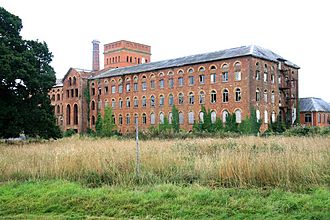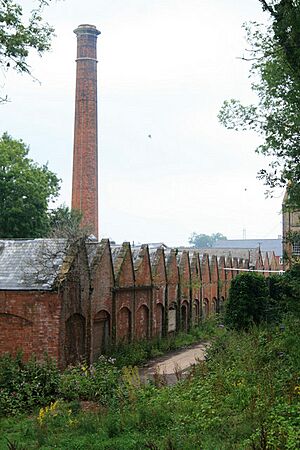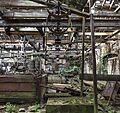Tonedale Mills facts for kids
Quick facts for kids Tonedale Mills |
|
|---|---|

Pictured in 2010
|
|
| General information | |
| Location | Wellington, Somerset |
| Coordinates | 50°59′05″N 3°14′40″W / 50.984828°N 3.244368°W |
| Opened | 1790 |
Tonedale Mills is a huge textile factory in Wellington, Somerset. It's the biggest one in the South West of England! For over 200 years, the Fox family owned it. They were famous for making a special fabric called 'Taunton serge'. Later, they made khaki cloth and puttees for the British Army.
The factory started in the mid-1700s. It grew a lot during the Industrial Revolution. At its busiest, it made about 6,500 meters (21,300 feet) of fabric every day. In the 1980s, most of the factory closed. This happened because it became cheaper to make fabric in other countries. But some small-scale production still happens there today.
Contents
History of Tonedale Mills
A long time ago, around the 1500s, the Were family in Wellington, Somerset started making a fabric called serge. They made it at home as a 'cottage industry'. Later, Edward Fox married Anna Were. Their son, Thomas Fox (born 1747), took over the family business.
Somerset was a great place for the wool industry. This was because many sheep were raised there. 'Taunton serge' was very popular. It was light but also thick enough. By 1750, the Were family had a 'fulling mill' at a place called Tone Works. A fulling mill is where wool fabric is cleaned and made thicker. Over the next 17 years, the family's business grew four times bigger!
Thomas Fox learned about the textile trade in Germany and the Netherlands. He joined the family business in 1768. By 1796, he owned it all by himself. He changed the company's name and added the 'FOX' mark to their cloth. In 1826, the company became known as Fox Brothers.
New inventions in the late 1700s completely changed how textiles were made. In the 1790s, Thomas Fox bought a group of buildings in Tonedale. These were called the 'Old Town Mills'. He wanted to bring all their work into one place. This helped them make better quality fabric and more of it. It also cut costs. They even did other jobs there, like basket weaving and metalworking.
The Tonedale site is special because you can still see how it used different types of power. It used water, steam, and electricity. When steam power came along, Fox Brothers kept their water system. They thought it might still be useful.
The factory kept growing throughout the 1800s. At its busiest, about 3,600 people worked for Fox Brothers around Wellington. They made about 6,500 meters (21,300 feet) of fabric every day. At Tonedale, the dyers (people who color fabric) created a special khaki dye. British soldiers wore this color during the Second Boer War.
Tonedale Mills was the biggest wool factory in South West England. It was also unusual because it did so many different jobs on one site. The mill made a lot of cloth until it got smaller in the 1980s. Most of the site is now empty. But some parts are still used for small-scale production. Other parts have been sold and turned into small businesses.
In 1994, the last Fox family house in Wellington, Tone Dale House, was fixed up. Ben and Victoria Fox restored it. Ben is a great-great-great-great-grandson of Thomas Fox. Since 1996, Tone Dale House has been used for events like parties and weddings. In 2009, two investors, Deborah Meaden and Douglas Cordeaux, put money into Fox Brothers. This helped the company keep making cloth at Tonedale when it was in trouble.
Exploring the Mill Complex
The Tonedale Mills site is actually made up of two main parts: Tone Works and Tonedale Mills.
Tone Works: Finishing and Dyeing
Tone Works is a bit north of Tonedale Mills. This is where they finished the cloth and dyed it. It sits next to the River Tone. The mills first used water wheels on the river to get power. You can still see where these wheels were.
Later, when steam and electric power were used, the river water was still important. It was used in the cloth finishing process. They managed the water carefully with a reservoir and special gates called sluices. The water was cleaned in the reservoir before they used it. Both the finishing area and the dye works were at this site.
Tonedale Mills: Wool Preparation
While Tone Works used the River Tone, Tonedale Mills used smaller streams. These were Westford Brook and Rockwell Green Stream. To make sure they always had enough water, Thomas Fox dug water basins between 1801 and 1803. He created a system of waterways, weirs, and sluices to control the water supply.
The first wooden mill here burned down in 1821. It was replaced by a brick mill, which is still there today. This large site has many mills, warehouses, workshops, and engine houses. Like the north site, you can still see signs of water wheels, steam, and electric power. The complex also had special factories for getting the wool ready. This included a combing shed and a wool cleaning area.
Future of the Mills
There were plans to turn some parts of the site into homes. But these plans were stopped in 2008. This was because of a big money problem around the world. Later, a group called The Prince's Regeneration Trust supported developing the site.
In 2010, the site was put on the Heritage at Risk Register. This means it's an important historical place that needs help. In 2014, the Tone Works site was named one of the top ten "priority" sites needing help in the South West. Most of the site has a special protection called 'Grade II* listed'. This helps preserve it. However, experts know that fully fixing up the whole site would be very expensive and difficult.
Images for kids








